Persecuted Cartoonists: Steady Hands and Brave Hearts
by Barbara Collier / September 23, 2011 / 3 Comments
“Books and all forms of writing are terror to those who suppress the truth,” writes Wole Soyinka, Nigerian poet, dramatist and Nobel Prize winner.
The political cartoon is arguably the most powerful format of that terror. More art than speech, the best editorial cartoons are lie-piercing tools in the fight for human rights. With scalpel-sharp wit, they carve away at political power where it holds unhealthy sway. And with their accessibility to a broad swath of followers—illiterate as well as educated—cartoons can become the banners of democracy.
However cartoonists provoke the anger of repressive regimes. The profession requires a steady hand and a brave heart.
In many parts of the world, cartoonists fight for their basic right to freedom of opinion. In perhaps the most infamous brouhaha in contemporary cartoon-publishing history, in September 2005, the Danish newspaper Jyllands Posten attempted to open up debate about a hands-off-Islam demand by the religion’s adherents. The paper published 12 editorial cartoons depicting the prophet Muhammad, which is prohibited under Islamic law. The deed stirred worldwide Islamic protests and retaliations, including the torching of Danish embassies and the attempted murder of one of the artists.
Just like Jylland Posten, there are many publications and cartoonists who have faced pressure from local and international authorities. But unlike the Jylland Posten case they don’t make international headlines.
Sampsonia Way asked writers who have collaborated with the magazine to recommend a cartoonist from their country. From Zimbabwe, it was recommended we contact Tony Namate; from Cuba, Alfredo Pong; from Venezuela, Pedro León Zapata; from Burma, Aw Pi Kyeh (APK); from South Africa, Jonathan Shapiro (Zapiro). We asked them about their careers and challenges and, while editorially we can’t vouch for every one of their opinions, we applaud their efforts to express them and be heard.
Tony Namate: “I Realized the Power of Cartooning, and Haven’t Looked Back Since.”
Tony Namate recently published a book of his cartoons, The Emperor’s New Clods: Political Cartoons from Zimbabwe, which the Association of American Editorial Cartoonists’ Kevin Kallaugher says, “The book punctures the pomposity of the powerful on behalf of the poor and the powerless.”
A picture on Namate’s Facebook page, taken in 1999, shows him at his Daily News desk drawing a cartoon. In April 2000 a homemade bomb was thrown at the paper’s office, and in 2001 a series of bombs were planted in the building, blowing up the printing press. In 2003 the paper, known for its critical views on President Robert Mugabe, was denied a permit and subsequently shut down. Namate now draws for the online periodical New Zimbabwe and also addresses the problems of other African countries.
VJ Movement’s website says of Namate, “His work is often open to different interpretations—an ambiguity he says not only protects him but also reflects the complicated politics of his country. He trusts in his readers’ capabilities to distill his message.”
SAMPSONIA WAY: How did you begin as a political cartoonist?
NAMATE: I grew up on American comics and British funnies that my father used to bring from work. I liked the drawings more than the text. Then, when I was in high school in the ’80s, I became addicted to Mad magazine. In high school literature courses I read Julius Caesar and Orwell’s Animal Farm. The resemblance of my country’s political situation to what I read shaped what was to become my political outlook.
SAMPSONIA WAY: What challenges have you faced in response to your cartoons?
NAMATE: I’ve been doing cartoons for over 20 years now, and I have had some close shaves. I’ve been threatened by government ministers and have been chased by a Zanu-PF mob because I “make fun of the President.”
SAMPSONIA WAY: Have you ever come close to giving up your work because of the difficulties imposed on you?
NAMATE: Political cartooning is a labor of love, but yes, there have been times when I thought of giving it up. I have no problem with reactions from politicians; in fact, I welcome their reactions. If their reactions are brutal, then my response is equally brutal. But making a living out of cartooning is not easy because the client base in Zimbabwe is so small and polarized. If you make cartoons for one paper, you can’t make them for another. And payment is a take-it-or-leave-it situation.
Alfredo Pong: “I Suffer an Incurable Case of Castrophobia.”
Alfredo Pong escaped Cuba for Vancouver, Canada in 1991, where he began to draw his first political cartoons. By 1994 he had been hired by the newspaper El Nuevo Herald in Miami, where he continued cartooning for several years. Then in 1998 he connected with the online publication La Nueva Cuba. These days his work is published on websites in the U.S., Brazil, Canada, Spain, Sweden, and Venezuela, and his personal blog can be accessed at cubahumor.com.
Reporters Without Borders has deemed Cuba “one of the world’s 10 most repressive countries, as regards online free expression.” Pong, who has admitted that he suffers an incurable case of “Castrophobia” is among many exiled journalists who continue to fight for a free Cuba.
SAMPSONIA WAY: How did you begin as a political cartoonist?
PONG: I think I started drawing before I could talk. It’s impossible to think of myself as a child and not see me drawing on anything I could find. Then, when I was 8 years old, I was in an art competition in which you used your fingers as paint brushes. I drew a picture of our national hero Fidel Castro and won first prize. Ironically, I had drawn a portrait of the young leader who would later become our tyrant in chief.
SAMPSONIA WAY: What motivated you to use your talent as a means of protest?
PONG: I belong to a generation that was the recipient of every socio-political and economic experiment of the new Cuban utopia, so I witnessed the decline and disintegration of the country we had inherited, the separation of families, the loss of all the material wealth that had been earned and accumulated by at least two generations of Cubans, the annulment of private property, and the right to choose a future for yourself. In short, I witnessed the total loss of individual freedom in the name of a new collective and mandatory way of living.
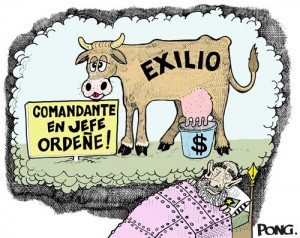
The revolutionary slogan 'Comandante en Jefe, Ordene' means 'Commander in Chief, give us your orders.' Pong modified the word 'ordene' (to give orders) to 'ordeñe', which means to milk a cow.
In Cuba I never published a political cartoon. I knew the publishing circles and almost all the official cartoonists, but I wasn’t willing to pay the price, which would have meant giving up all autonomy and working according to the official “script” of the regime. Instead, I drew comic strips clandestinely, for my own amusement, occasionally sharing some of them with a select group of friends.
When I managed to escape Cuba in 1991, I began to get all that off my chest: The frustration of spending my whole life without being able to denounce the things I had seen, without having the freedom to express my point of view, and always having to look over my shoulder.
SAMPSONIA WAY: Have you ever come close to giving up your work because of the difficulties imposed on you?
PONG: Since the beginning, they have tried to pressure me in all kinds of ways, some very subtle, like trying to block my participation in international graphic humor competitions, or sabotaging the publication of a book that was published in Brazil, which was a collaboration with political analyst Jorge Hernández Fonseca. We put together a book with his work and mine, which was supposed to be released during the International Book Fair in Miami, but it was sabotaged during printing, so it couldn’t be ready for that. Also, none of my cartoons have ever been seen in Cuba because the government blocks all blogs or websites with content that is critical of the regime. I have also received a number of online attacks in different forms.
SAMPSONIA WAY: Have you ever considered stopping your work because of these difficulties?
PONG: Well, I don’t get paid to do this. I live off my work as an architect. Nobody pays me, nobody tells me what to do, and I don’t use ideas other than my own. That gives me a great deal of independence and freedom with my cartoons. I am the only person responsible for what I say, which makes me very happy. I would love for my colleagues in Cuba to be able to enjoy that freedom one day.
Pedro León Zapata: “One Doesn’t Become a Cartoonist, One Unbecomes Oneself.”
Pedro León Zapata isn’t afraid to pick fights —even if his opponent is Hugo Chávez, Venezuela’s authoritarian President. The Caracas-based artist, winner of the Premio Nacional de Artes Plásticas, has been a regular contributor to the popular Venezuelan newspaper El Nacional for nearly 50 years through his column, “Zapatazos.” Interviewed by Elizabeth Farnsworth on PBS in 2002, he said, “How can you explain what is happening in Venezuela if even we Venezuelans can’t understand it? What is happening in Venezuela doesn’t have a logical explanation… In astronomical terms, El Comandante Chávez is a black hole… For me, cartoons are the perfect form for expressing fully all that happens to me inside as a consequence of what is going on outside.” Farnsworth describes Zapata as “a man with a strong appreciation for black humor and the absurd.”
In the ’40s, Zapata moved to Mexico to study with the muralists Diego Rivera and José Clemente Orozco. Over the many years since his return to Venezuela, he has become a nationally known political gadfly and unique artist—painter, muralist, illustrator, playwright, radio host, actor, and musician—revered for both his humor and his implacable challenge to Chávez.
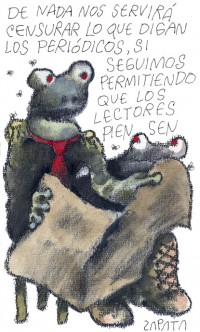
According to Zapata, this cartoon represents Chávez's party members as toads with epaulettes and military boots. In Venezuela, 'sapo' (toad) is a pejorative term for informants or tattlers.
In 2000 there was a confrontation with the Venezuelan leader, who publicly challenged Zapata about these cartoons, asking whether he had been bribed to publish them. Zapata answered the President with another question: “Mr. Chávez, did you accept money to refer to my cartoons, thus inducing so many people to rush out and buy the newspaper?”
Zapata is featured on Chávez’s list of “counter-revolutionaries” — a collection of artists, journalists and other “public enemies” the President recommends go into self-imposed exile. Although we asked him about his conflict with Chávez, Zapata preferred talking about his public reception.
SAMPSONIA WAY: How did you become a cartoonist?
ZAPATA: One doesn’t become a cartoonist, one unbecomes oneself. I would like to have another profession, but for many reasons I can’t. For example, I wanted to be an architect, but people praised my cartoons so much that I took that path.
SAMPSONIA WAY: What challenges have you faced as a response to your cartoons?
ZAPATA: People really like my cartoons, at least they say so. The only challenge I face is to please the readers without being indulgent.
SAMPSONIA WAY: Have you ever come close to giving up your work because of the difficulties imposed on you?
ZAPATA: I haven’t found a great deal of difficulty in my work, just affection. Nothing has yet made me think about quitting my job as a cartoonist.
Aw Pi Kyeh: “About 300 of my Cartoons Were Censored in my Life.”
Aw Pi Kyeh (APK) chose this pen name because it means ‘loudspeaker’ in Burmese. His cartoons dare to shout out loud about the military junta that rules Burma. In 2007 he was banned from publishing inside Burma after he supported monks in their peaceful protests during the Saffron Revolution. Following that, colleagues who even mentioned his name in an article were suppressed.
In June 2011, the Burmese site Mizzima.com, compiled the views of several well-known Burmese on the fighting between the national troops and the Kachin Independence Army, after both sides suffered heavy casualties. Aw Pi Kyeh commented, “The president said they would try to be a good government. What does good government mean? Is fighting good?”
After 30 years of cartooning, Aw Pi Kyeh says he will not quit. He continues to illustrate despite the ban on his work, and he has turned to new channels of distribution such as Facebook.
SAMPSONIA WAY: How did you begin as a political cartoonist?
APK: I have loved cartoon drawings since I was 9 years old and began copying them. Then I discovered editorial cartoons in newspapers: Not only pictures, but ideas! So I began sending some of my own cartoons about current events to newspapers, but without success. When I reached university, though, my work achieved campus-wide fame. In 1980 editors of magazines began to print my cartoons, and I was given a monthly platform. But at that time in Burma, editorial cartoons were published strictly for propaganda. As soon as I was seen as having new ideas, I was not asked to draw regularly, and in fact I was appointed as an engineer in a factory that was far away from Yangon, where there was no post office. So in 1988 I resigned and became a full-time freelance cartoonist.
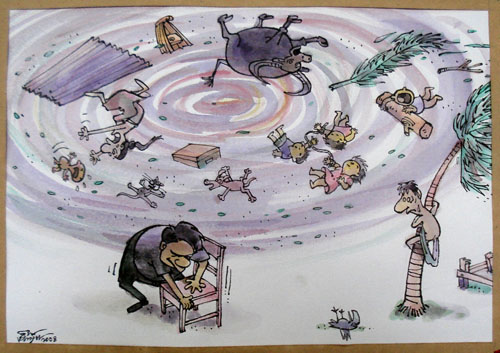
After Burma suffered the loss of more than 138,000 lives and damage estimated at $10 billion in Cyclone Nargis in May 2008, the Burmese military regime held a referendum to retain its power. The cartoon depicts a man in trousers (a symbol of a military person) carefully righting his chair (a symbol of power) while ignoring the plight of victims being blown about in the cyclone.
SAMPSONIA WAY: What challenges have you faced as a response to your cartoons?
APK: The crucial challenge is censorship. The Press Scrutiny and Registration Division (PSRD) reads all published books, newspapers, and magazines and censors any pages they don’t like. Publishers and editors need to tear out or ink over those pages. All my cartoons were chosen to be published in magazines, but some were censored. Whenever a page with my cartoon on it is torn out, the cartoon on the back is also tossed out. The editors must allow the PSRD to check their publication again after the deletions. It can take more than a week and delay distribution. So I am a major headache for my editors. Though they would like to publish my work, I am the cartoonist most prone to censorship. I’ve had about 300 of my cartoons cut out of publications in my career.
SAMPSONIA WAY: Have you ever come close to giving up the work because of the difficulties imposed on you?
APK: No. After I resigned from my engineer job, I was determined to be a freelance cartoonist for the rest of my life. I have tried to survive economically, even with a wife and three children. When my cartoons were censored, sometimes I was not paid, so I have also done cartoon illustration, computer graphics, and animation related to cartoons. From time to time, I worked as an external supervisor for some NGOs in creating information, education, and communication materials. Now I draw cartoons not only for criticism but to inform and educate the Burmese people. Cartoons are an easy, effective tool for this purpose. I am particularly interested in using my cartoons to promote environmental issues, disaster management, and early-childhood development. I would never give up my cartoon work because I have so many goals to achieve that censorship will not impact.
Zapiro: “I Was Detained Without Trial in 1988.”
Jonathan Shapiro (Zapiro), born in Cape Town, South Africa, fulfilled his military requirement before becoming active in the anti-apartheid movement, the United Democratic Front. In 1988, on a Fulbright scholarship, he studied at the School of Visual Arts in New York City with premier comic artists Art Spiegelman and Harvey Kurtzman.
Today Zapiro is a noted editorial cartoonist with a busy schedule drawing for South Africa’s Mail & Guardian and Sunday Times. He has published 16 book compilations of his work and received the 2007 Courage in Editorial Cartooning award from the Cartoonists Rights Network International, which monitors and supports the well-being of political cartoonists who find themselves in trouble because of the power and influence of their professional work. For several years, he’s been an invited speaker at the World Economic Forum in Davos.
According to the Daily Maverick, “He didn’t censor himself before the apartheid government (and he was jailed for it), he doesn’t censor himself to appease big business, and he certainly doesn’t censor himself to please the African National Congress—he is one of those who takes most seriously Section 16 of the South African constitution, the part where freedom of expression is enshrined.”
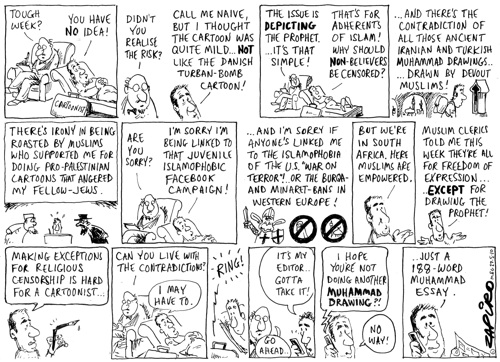
South African cartoonist Zapiro responded to the threats that followed his cartoon of prophet Muhammad visiting the psychologist by drawing himself on the therapist’s couch. While maintaining the right to draw, he dissociated himself from the “juvenile Islamophobic Facebook campaign,” the Islamophobia of the U.S. war on terror, and the European bans on the burqa and minarets.
SAMPSONIA WAY: How did you become a cartoonist?
ZAPIRO: From the age of 8 or 9, I knew that cartooning was my favorite thing. At 4, I remember reading [Carl] Giles. But the big ones for me were Peanuts and Tintin, which I discovered at about 7 and 8. Those cartoons are still two of my great inspirations. Schulz and Hergé are geniuses. At 13, I started to make a book based on the Tintin action films to impress Hergé and get him to let me be part of his team. Then I decided, no, I wanted to do my own stuff.
At the age of 15, there was some pressure to “be something,” and, of course, there was that ogre, the army. I thought I’d better do something “proper” to stay out of the bloody army. Architecture seemed a good marriage of arts and science. I got into Cape Town University easily enough, but I realized architecture was not where my heart was.
Although I thought of being a cartoonist from a young age, it was only when I became a political activist in my mid-20s that I really became a cartoonist. Drawing cartoons for political organizations is what really got me started.
SAMPSONIA WAY: What challenges have you faced as a response to your cartoons?
ZAPIRO: I’ve been involved in a large number of controversies around my cartoons, beginning with the very first political pamphlet I ever did, which was banned by the apartheid government in 1983. Other bits of graphics and cartoons I did were also banned. I was interrogated by the security police about one of them and was detained without trial in 1988. The same year an apartheid cabinet minister ranted in parliament about cartoonists, apparently attacking me and a colleague. Many of my cartoons about political, religious, and sexual issues have been controversial and have sparked debate in newspapers and other media.
But nothing I’ve ever done has come close to creating the kind of media frenzy and public debate sparked by my September 2008 Sunday Times “Rape of Justice” cartoon.
SAMPSONIA WAY: Have you ever come close to giving up the work because of the difficulties imposed on you?
ZAPIRO: For me the problems that I sometimes face are part of the job. My best way of dealing with this is to keep doing hard-hitting cartoons and not get intimidated. I have no plans to stop doing cartoons.

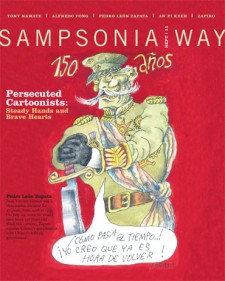
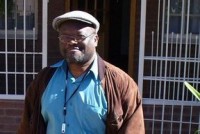
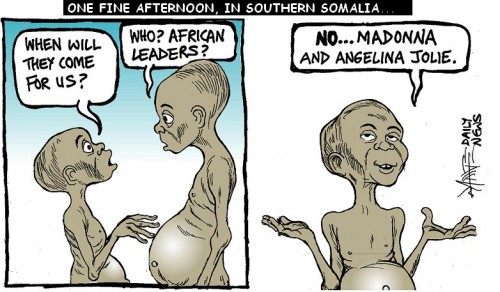

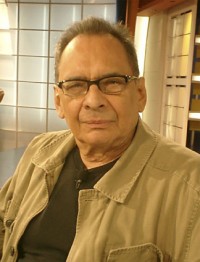
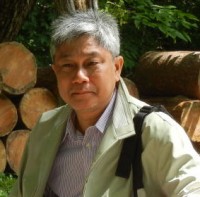





3 Comments on "Persecuted Cartoonists: Steady Hands and Brave Hearts"
cartoon story writting is a great art only few persons know the attainment of this who have the perfect connection with hardwork
It’s an remarkable piece of writing for all the online people; they will take advantage from it I
am sure.
Trackbacks for this post